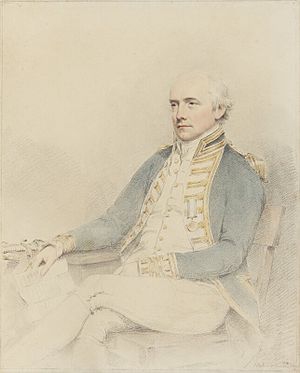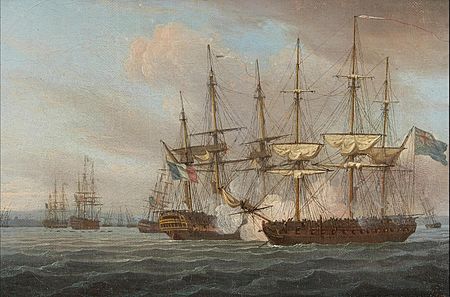James Gambier, 1st Baron Gambier facts for kids
Quick facts for kids
The Lord Gambier
|
|
|---|---|
 |
|
| Born | 13 October 1756 New Providence, The Bahamas |
| Died | 19 April 1833 (aged 76) Iver, Buckinghamshire, England |
| Buried |
St. Peter's churchyard in Iver
|
| Allegiance | |
| Service/ |
|
| Years of service | 1767–1833 |
| Rank | Admiral of the Fleet |
| Commands held | HMS Thunder HMS Raleigh HMS Endymion HMS Defence |
| Battles/wars | American Revolutionary War French Revolutionary and Napoleonic Wars |
| Awards | Knight Grand Cross of the Order of the Bath |
Admiral of the Fleet James Gambier, 1st Baron Gambier (born October 13, 1756 – died April 19, 1833) was an important officer in the Royal Navy. He fought in major wars like the American Revolutionary War and the French Revolutionary and Napoleonic Wars.
One of his famous moments was at the Glorious First of June battle in 1794. He commanded the ship HMS Defence. His ship was the first to break through the enemy's battle line. Later, he became a top leader in the Navy. He also served as the Governor of Newfoundland. He helped lead the attack on Copenhagen in 1807.
Contents
James Gambier was born in the Bahamas. His father was the Lieutenant Governor there. James was raised in England by his aunt and her husband, Admiral Charles Middleton, 1st Baron Barham. He joined the Navy in 1767 when he was just 11 years old.
He started as a midshipman on HMS Yarmouth. He then served on other ships, including HMS Salisbury and HMS Chatham. He became a lieutenant in 1777.
First Commands and Battles
In 1778, James Gambier became a commander. He took charge of the bomb ship HMS Thunder. This ship was quickly damaged and captured by the French. After being a prisoner for a short time, he was set free.
He then became a post captain in 1778. He commanded Template:USS Raleigh (1776). He helped capture Charleston in May 1780 during the American Revolutionary War. After the war ended in 1783, he was put on half-pay, meaning he wasn't actively serving.

When the French Revolutionary Wars began in 1793, Gambier was given command of HMS Defence. He was known for being a very religious man. Some sailors even called him Dismal Jimmy. At the Glorious First of June battle in 1794, his ship was the first to break through the French line. For this brave action, he received a special medal.
In 1795, Gambier joined the Board of Admiralty, a group that managed the Royal Navy. He was promoted to rear-admiral that year. In November 1795, he became the First Naval Lord, which is a very important leadership role.

He became a vice-admiral in 1799. After leaving the Admiralty for a short time, he became the governor and commander-in-chief of Newfoundland Station in 1802. There, he helped local people get land rights for farming and housing. Around this time, he also bought a home called Iver Grove in Buckinghamshire.
Gambier returned to the Admiralty as First Naval Lord in 1804. He was promoted to full admiral in 1805. He served a third time as First Naval Lord in 1807.
The Copenhagen Attack
In May 1807, Gambier volunteered to lead the naval forces in a campaign against Copenhagen during the Napoleonic Wars. He worked with General Lord Cathcart. They oversaw the bombardment of Copenhagen. The city was heavily bombed from September 2nd until the Danes gave up after three days.
The British captured many ships and naval supplies. For this success, Parliament thanked Gambier. In November 1807, he was given a special title, becoming Baron Gambier.
The Basque Roads Incident

In 1808, Gambier was put in charge of the Channel Fleet. In April 1809, he chased a group of French ships into the Basque Roads. Another commander, Lord Cochrane, led an attack using special explosion ships. This made most of the French fleet get stuck in shallow waters.
Gambier decided not to send the rest of his fleet into the shallow area to finish off the French ships. Some people, like Admiral Sir Eliab Harvey, thought he missed a big chance. Harvey even told Gambier he wasn't fit to command a fleet.

Lord Cochrane was very upset. He threatened to speak out against Gambier in Parliament. Because of this, Gambier asked for a special hearing, called a court martial, to look into his actions. The court martial happened on July 26, 1809. It decided that Gambier had acted correctly. After this, neither Harvey nor Cochrane were given commands for the rest of the war.
Later Years and Legacy
In 1814, Gambier was part of the team that negotiated the Treaty of Ghent. This treaty officially ended the War of 1812 between Britain and the United States. He received another high honor in 1815.
On July 22, 1830, he was promoted to Admiral of the Fleet, the highest rank in the Royal Navy. He passed away at his home in Buckinghamshire on April 19, 1833. He was buried in Iver.
Gambier is remembered in several ways. He helped start Kenyon College in the United States. The town of Gambier, Ohio is named after him. So is Mount Gambier, a city and volcano in Australia. Gambier Island in British Columbia is also named for him. He even appears as a character in a book called Flying Colours.
Personal Life
In July 1788, James Gambier married Louisa Mathew. They did not have any children.
See also
- Governors of Newfoundland
- List of people from Newfoundland and Labrador


